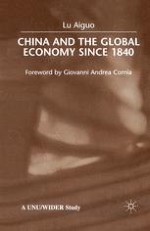2000 | Buch
Über dieses Buch
This is a study of the long-run evolution of the relationship between China and the world economy. The book presents an original interpretation of the country's socio-economic processes in the past 150 years, focusing on China's interaction with the expanding capitalist world economy. The author argues that the general thrust of China's quest for development or 'modernization' has been to catch up with the wealthy nations of the West, and goes on to explain the changing paths and outcomes. The book proceeds chronologically from China's mid-nineteenth-century incorporation to the world economy, starting from a semi-colonial state to the Maoist state-led industrialization after 1949, and to the post-Mao liberalization and reintegration. By carefully examining the patterns of development in these three major periods of the nation's history, it addresses fundamental issues pertaining to the making of modern China. This rigorously argued book will be a timely and much debated contribution, as the `rise of China' in the twenty-first century has become an issue of our time.
Anzeige
